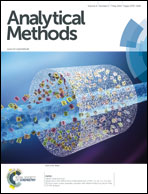Rapid microchip-based FAIMS determination of trimethylamine, an indicator of pork deterioration†
Abstract
A fast and quantitative method for the detection of biogenic amines based on the microchip-based high-field asymmetric waveform ion mobility spectrometry (FAIMS) technique was established for evaluating the degree of spoilage of pork stored at room temperature. Trimethylamine (TMA) was selected as a good indicator for its volatility and high proton affinity. Analysis of standard TMA showed the same characteristic peak with the pork sample. The limit of detection of the system for TMA dissolved in deionized water, with 100 μL of 8 mol L−1 NaOH, was 3 ng and the measurement was accomplished within 15 s. The relative standard deviation (RSD) was 6.20%. The delivery of the sample gas was based on the dynamic headspace method. The effect of the storage time on the formation of biogenic amines was examined, and not surprisingly, the content of TMA increases over time. The total volatile basic nitrogen (TVB-N) was measured simultaneously based on the classical semi-micro Kjeldahl method. A good correlation coefficient between these two methods was obtained, the correlation coefficient was 0.952. Therefore the microchip-based FAIMS technique provides a quantitative classification of the spoilage or freshness of pork, especially when a rapid detection is needed.


 Please wait while we load your content...
Please wait while we load your content...